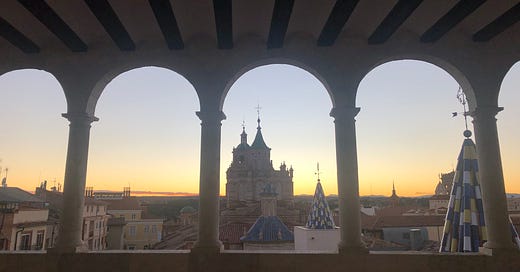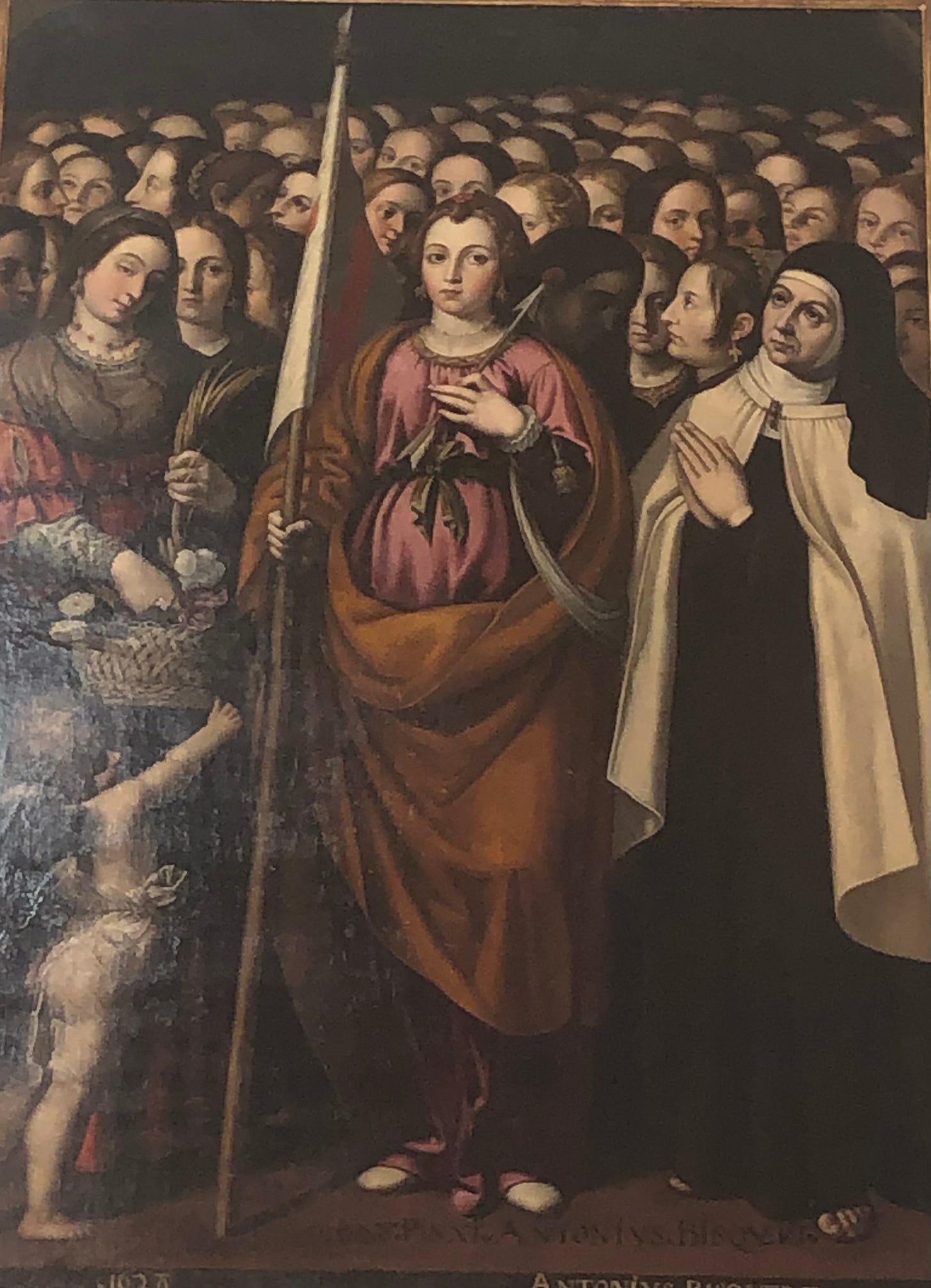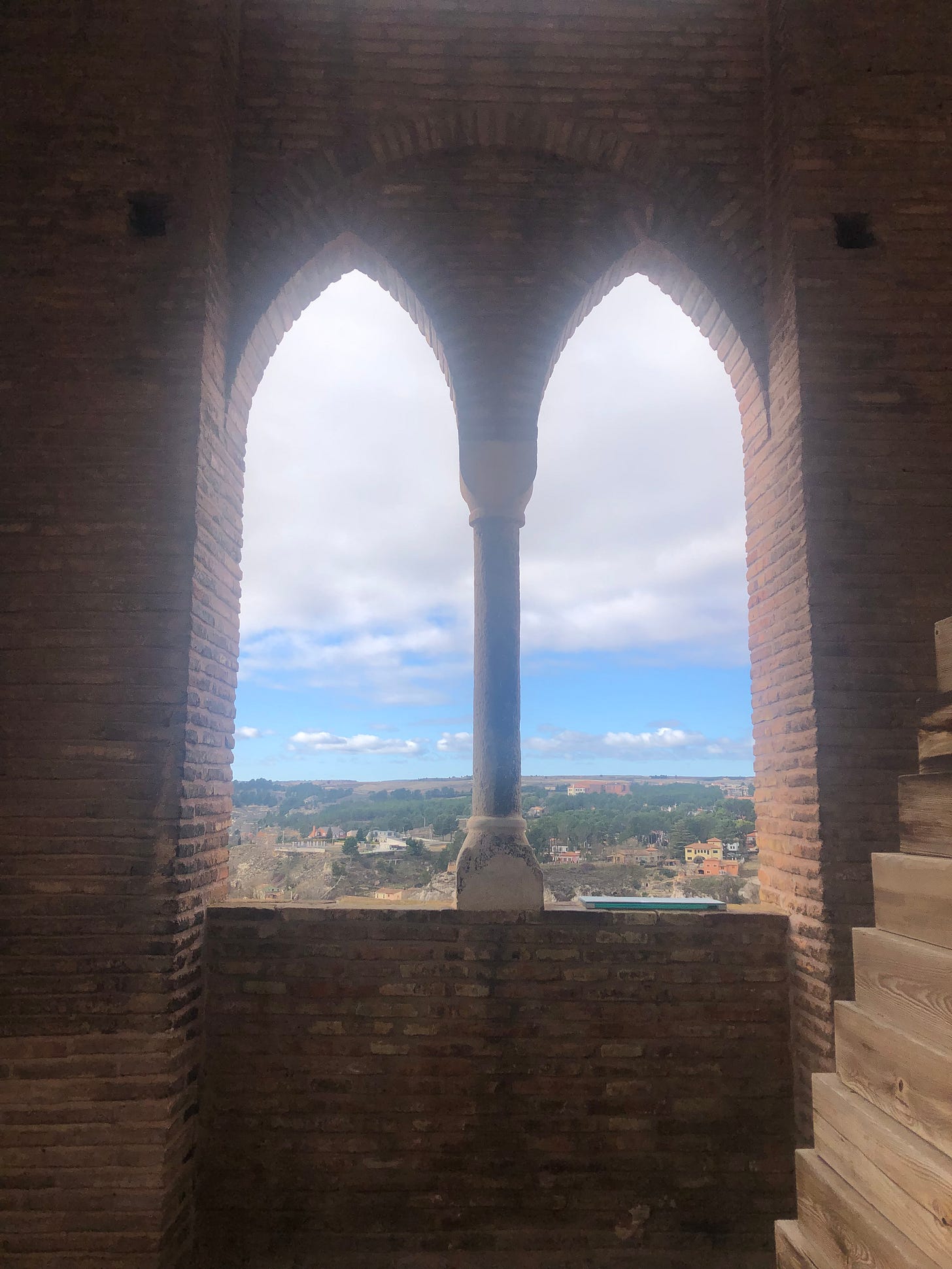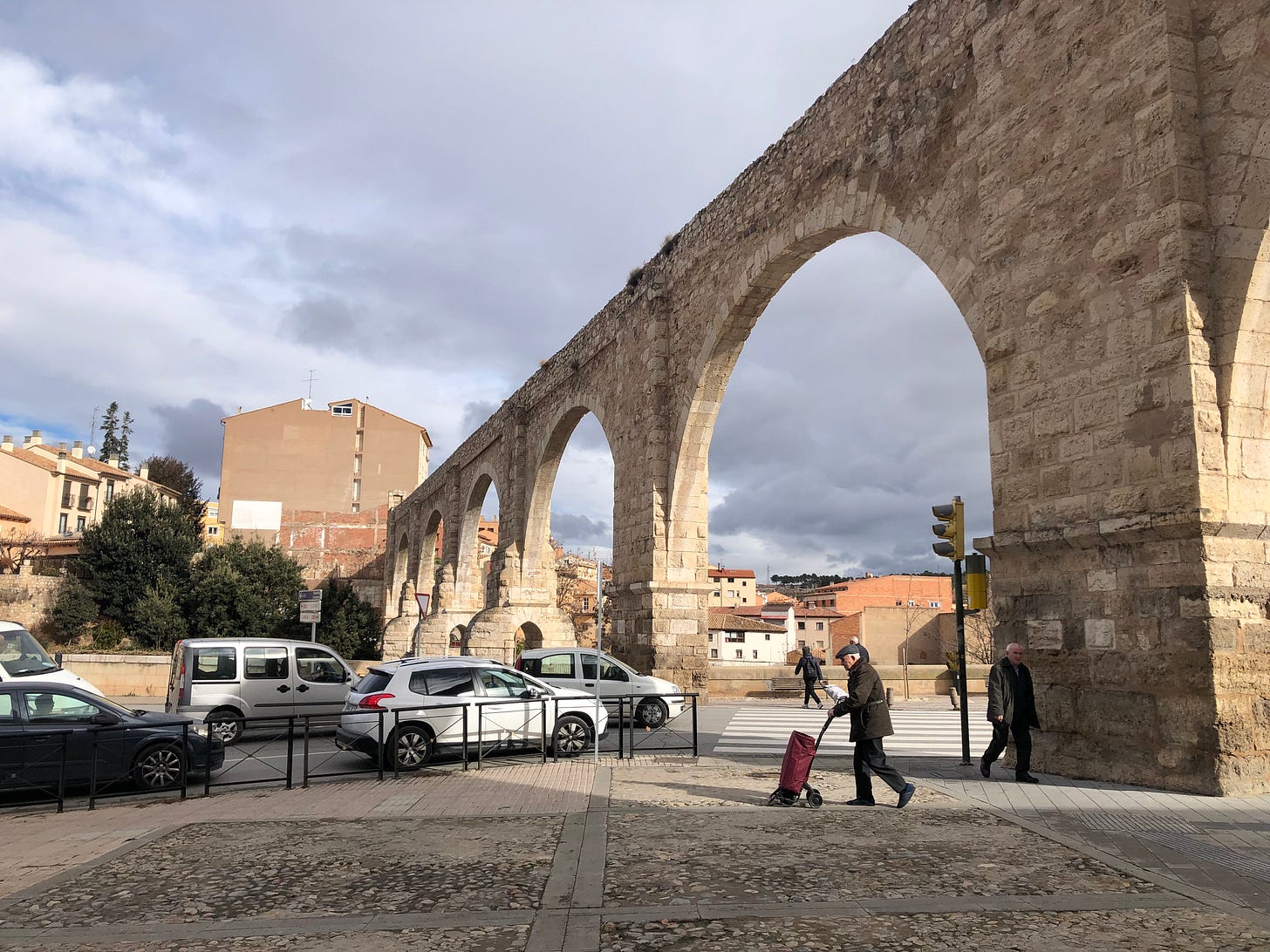For those of you who are still a little skittish about traveling unplugged yourselves, I think I may have found the perfect way to ease into it: go to Teruel.
Teruwhat, you say?
Teruel is a Spanish town of about 35,000, located about four hours northeast of Madrid by train. I didn’t know much about it before I arrived beyond the fact that it was the setting for Spain’s version of Romeo and Juliet and that it had, according to my dear friend Nancy, some stunning mudéjar architecture. But it only took me a couple of hours to realize that it was by far the most accessible and least stressful trip trip I’ve taken for this newsletter.
At key points where you might be tempted to reach for your phone and open your navigation app, Teruel has beat you to it, with You are Here maps, fetchingly made of painted ceramic tiles, there to orient you. The town’s compact size and position make it easy to navigate, with pretty much everything you want to see crammed onto one hilltop, and not so many hotels that you couldn’t check them all out (as I did) simply by walking around for an hour or so. It has a range of interesting historical sites and streets that teem with the kind of life that Spanish cities do so well, to keep it from feeling boring. Best of all –and this is a result, I suspect, not just of size but of culture— Teruel is the kind of place that makes it easy to connect.
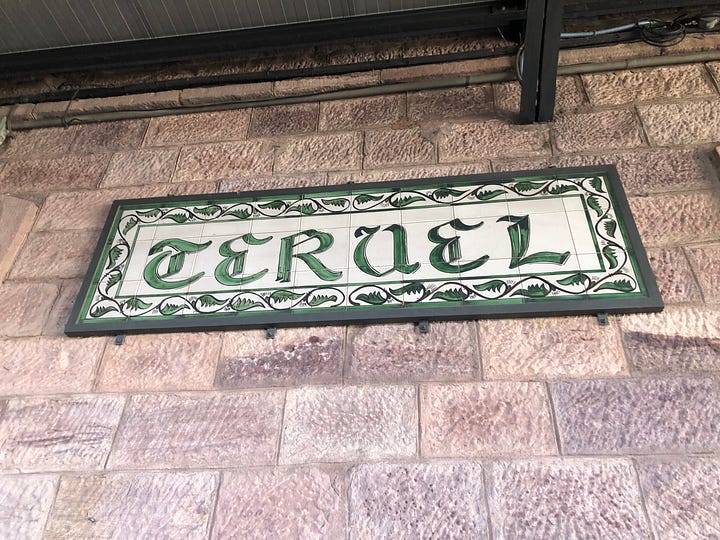
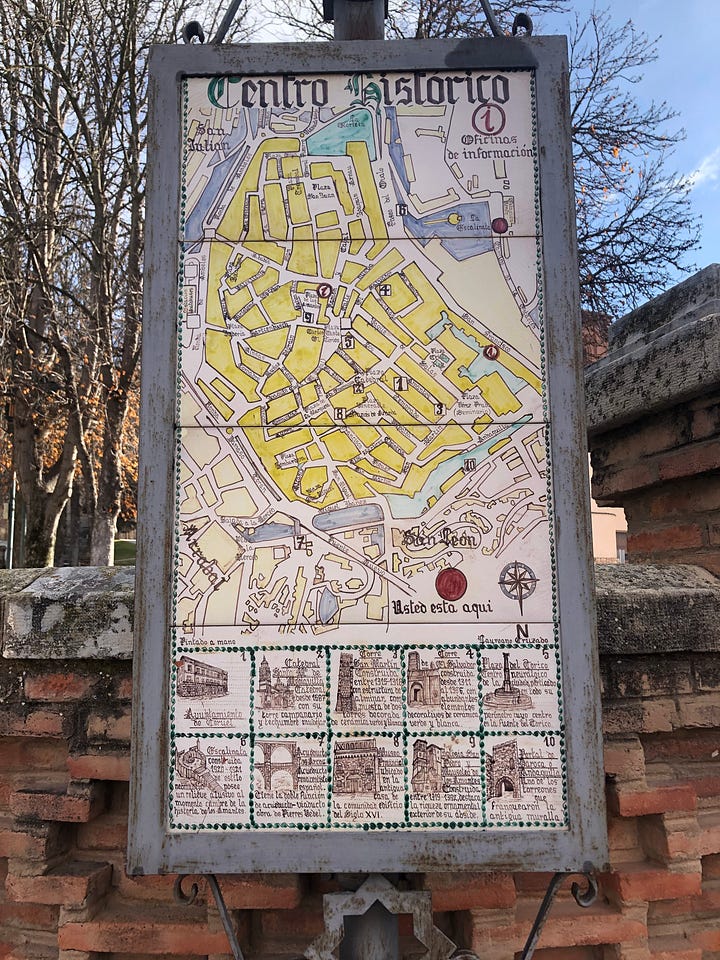
When I got my first inkling of that, I figured it was just professional courtesy. I was checking into the hotel I had chosen after indeed scoping out all the options, when I fell into an extended conversation with the receptionist, Cristina. She had grown up in Teruel, then left for hotel jobs in more glamorous locations like Mallorca and London. But Covid spooked her, and when it was over, she returned home. At this point in her life, she told me, she appreciated Teruel’s virtues, “The pandemic taught me I didn’t want to live on islands anymore,” she said.
As my first order of business, I set out to find the tourist office, but walking streets lined with small shops, I quickly became distracted by an unusually alluring scent of roast chicken (roast chicken is, of course, already in the upper pantheon of divine aromas but this one was was like a tractor beam of deliciousness) out through the old city walls and around to the imposing aqueduct, where the weekly market was underway. Crates of citrus, tables of dried fish, and a guy in a truck roasting birds on a spit. I contemplated buying one and ripping it apart with my bare hands, but it was only 11 am, and none of them were done yet.
Chickenless, I opted for some architecture instead. The word mudéjar refers to the Muslims who continued to live in Spain after the Christians reconquered it in the Middle Ages, and derives from the Arabic for those “allowed to stay behind,’ which is pretty melancholic when you think about it. Today though, it is applied more commonly to buildings than to people, and is the name for the mesmerizing architectural style those who stayed behind created: part Islamic, part Gothic.

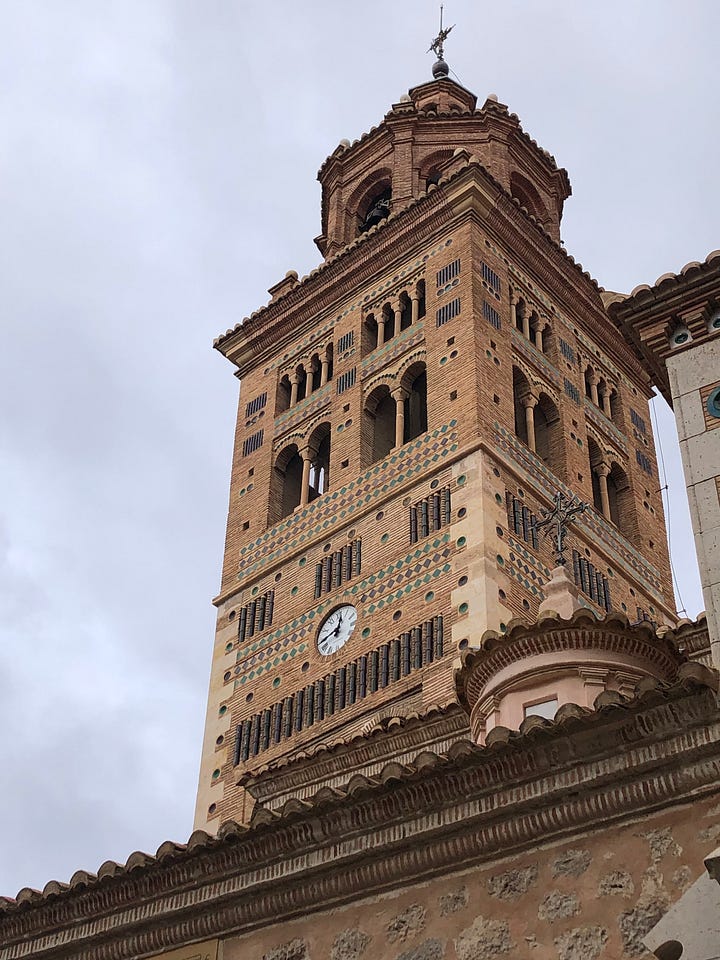
Teruel is so chock full of mudéjar architecture that UNESCO named it a World heritage site. I climbed El Salvador tower, which is actually two towers, one inside the other, with a stairway in between, and peered out through its keyhole windows at the city below. I gawked at the intricate plasterwork and glazed tiles that adorned the San Martín tower in hypnotically geometric patterns. Inside the Cathedral, I strained my neck staring up at the ornately carved wooden ceiling (though to be honest I was more struck by a painting depicting Saints Teresa and Ursula at the head of a fierce-looking army of angry virgins). And I was dazzled by the modernist riffs on display in the neo-Mudejar (part Islamic, part Gothic, part Gaudí) San Pedro church and the whimsically imposing escalinata –or stairway–that leads up to the town.
But none of that is what made Teruel so perfect for our purposes.
On my first lap around the town, I came across a ramshackle inn. It was shuttered at the time, but a pamphlet taped to its exterior, identified it as both one of the oldest still-operating posadas in Spain, and as a former hotbed of Lutheranism, of all things. There was no way I was missing that, so that night, I returned, and found a cavernous old room, where small groups of friends huddled around rough wooden tables, drinking happily beneath rusty shovels and tools that the bartender told me had been left decades or even centuries earlier by previous travelers. The family of the current owner had bought the place, he said, for two chests worth of saffron.
He set a plate of salty peanuts next to my beer, and as I tossed their shells onto the floor (a distinctly Spanish pleasure, that guiltless indoor littering), a man with a duffle bag, a frizzy mop of dark hair, and an Argentine accent sat next to me and ordered a glass of wine. I looked over at him, expecting to make conversation since we were both alone and both obviously foreigners passing through. But he pulled out his phone before I could make eye contact.
I talked some more to the bartender, whose name was Anton, instead. Originally from Madrid, he had moved with his small family to Cadiz on the southern tip of Spain to pursue a career in the music business. But the business went bust (“Me arruiné”—I ruined myself—is how he described it, which means he went bankrupt but sounds much worse). His wife left him, taking their young daughter with her. His parents had moved to Teruel some time earlier, so he followed them there, only to have each of them die soon after. That was twelve years ago, and despite all the tragedy, he had stayed. “It’s tranquil here,” he said. “I’m at peace.”
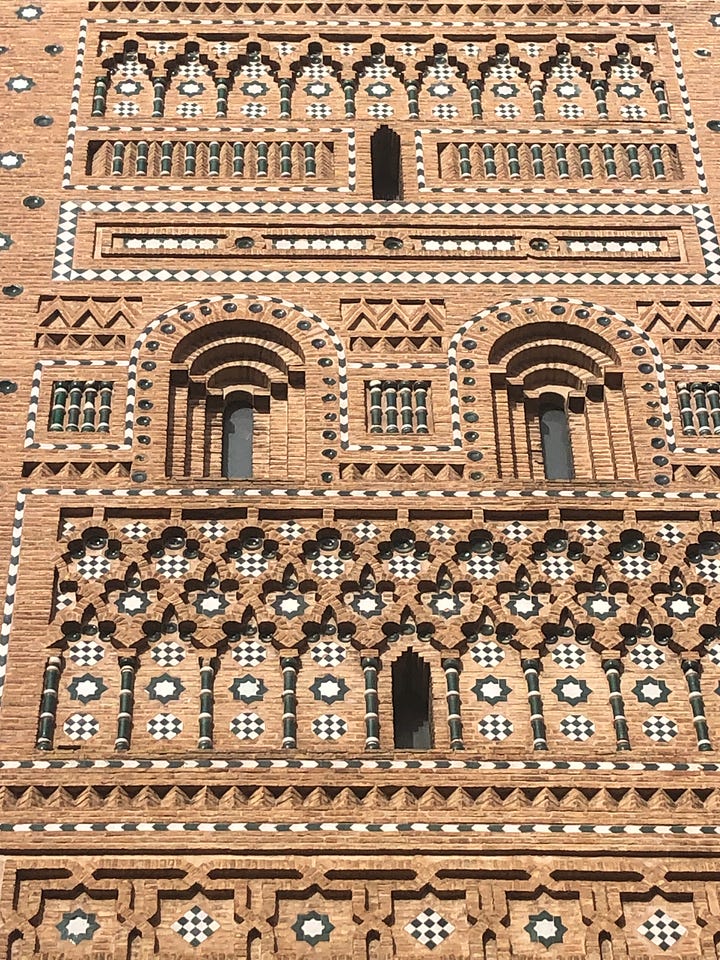
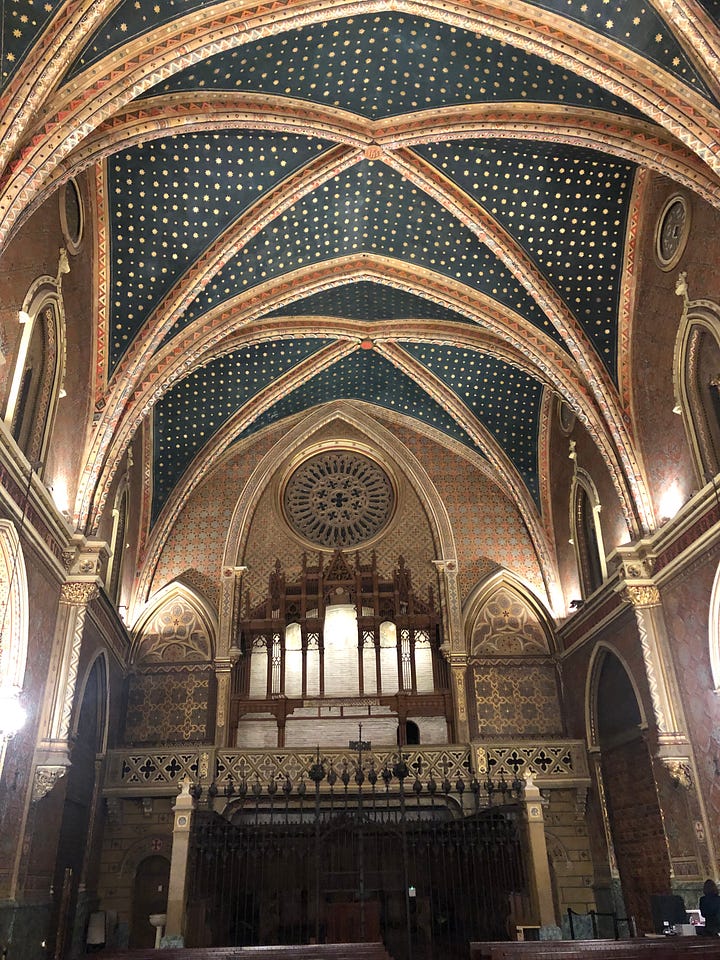
There didn’t seem to be any food besides peanuts at Fonda del Tozal and I was getting hungry, so I headed back to Teruel’s main street to find some dinner. I managed to wedge myself at the bar of a narrow, packed tapas place and was marveling at the owner, who did double duty as bartender and jamón slicer, when the Argentine man walked in and squeezed himself next to the wall. This time there was a flicker of a nod in my direction before he quickly pulled out his phone again. I went back to watching the bar’s owner, who would periodically disappear into the back, and return with a platter of something alluring like pork rib sandwiches in barbecue sauce, and the guests, who had until then been distributed around at tables, would swoop down on him like happy vultures and snatch them away.
I was writing bocadillos de carrillada y salsa barbacoa in my notebook when a man next to me asked if I was a journalist. C, as I’m going to identify him for reasons that will become clear later, was a journalist himself, writing for the local paper. He was probably in his 50s, with silvery hair and a black leather jacket. He asked if I wanted another glass, and turned out to be both affable and interesting, as we talked about Spanish history and American politics and the local school board meeting he had covered earlier that day. The place had pretty much cleared out by the time we had finished lamenting, in the way of journalists in bars everywhere, the collapse of our professionr. When we said goodnight, I felt like I had made an actual friend.
Or maybe more than a friend? C texted me the next day, but since I don’t use my phone when I’m out, I didn’t see it until I got back to the hotel late in the afternoon. I wasn’t sure, but it sounded like he was maybe asking me out. “I’d like to see you again,” he wrote.
My heart sank a little because I wasn’t really interested in him in that way. Still, here at The Unplugged Traveler we are all about saying yes to experiences that present themselves, and so instead of following my natural inclination to politely decline and hole up in the hotel for the rest of the evening eating ham sandwiches and watching Spanish tv, I decided to accept. Before I could respond, though, I got an email from him. Again–albeit less ardently–he asked to get together. But this time he added that it was in order to interview me for the paper.
Ah yes, the old ”interview” ploy.
I made my way to the bar he had recommended to find it even more frenetic than the previous night’s one. C arrived soon after me, and we squeezed into a corner table. The small talk was awkward enough that it certainly felt like a date. So when he suggested, after one glass and a tuna and red pepper pintxo, that we go somewhere quieter for the interview, I thought to myself: Way to commit to the bit, dude.
At the second place–overlit, with obviously inferior food– C went to the bar to order us a couple of glasses of wine, and returned with an entire bottle, a plate of ham, and a veritable tower of toasted bread. He pulled his stool close and looked at me questioningly. And then, sure enough, he pulled out his notebook.
He asked me what I liked about Spain, what I was doing in Teruel, and what kind of things I covered as a journalist. He wrote down everything I said. He took a photo of me to use with the story. It was definitely an interview.
But it was also an interview in which he let me know that he and his wife had been going through a rough patch, and although they were now reconciled, he spent the workweek in an apartment in Teruel, and only returned to the home they shared in another city on weekends. Except for the weekends when he was on call for the paper. Like this one. Those he also spent in his apartment in Teruel. Alone.
There was a question hanging in the air, but since he never actually asked it, I didn’t have to answer it. I could walk out into the cold night air, thank him sincerely for the evening and bid him good night. And then, relieved and more than a little amused, I could walk back to my hotel alone.
What I couldn’t do, still, is tell you if that was a date or an interview or a half-hearted attempt at a hookup. But my confusion aside, my talks with C– like the conversations I had with Christine and Anton—felt real. We had gotten beyond social niceties to share substantive things about ourselves. And I had learned enough about each of them, I realized, to recognize them all as modern-day mudéjars, people who had each chosen Teruel as the place where they would stay behind.
I was pondering all this the next morning when I went for breakfast at a bakery-café where the pastries were unusually interesting. (The same could not be said, however, for their nomenclature. When I asked the server what the pastry with the cross was called, she answered, “pastry with a cross,” then apologized for the collective lack of creativity.) The Argentine man was there too, and it made me reflect on what must have been our very different experiences of Teruel. Because, of course, when I entered and again when I left, he was looking at his phone.
The Addresses
Below, you’ll find a list of the places where I ate, drank, and stayed in Teruel. But, a gentle reminder: wouldn’t it be more fun to find your own?

